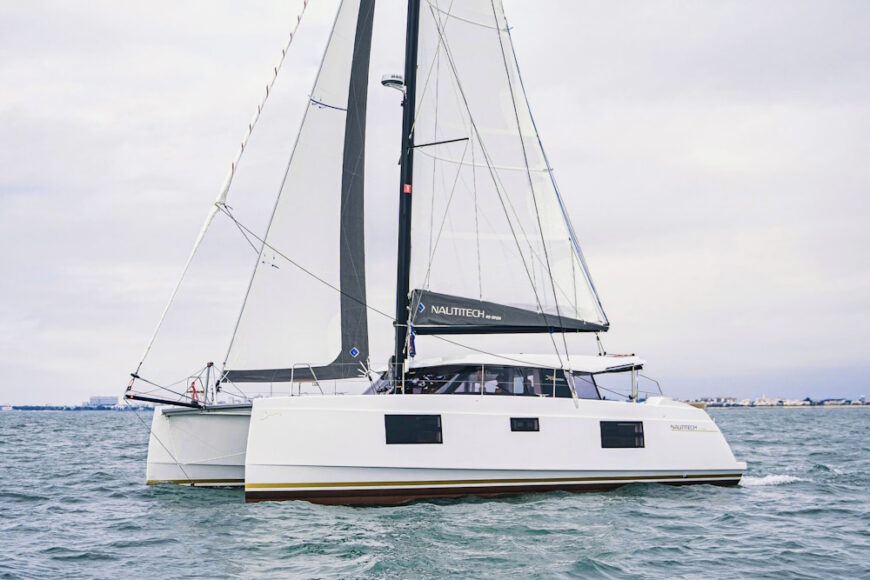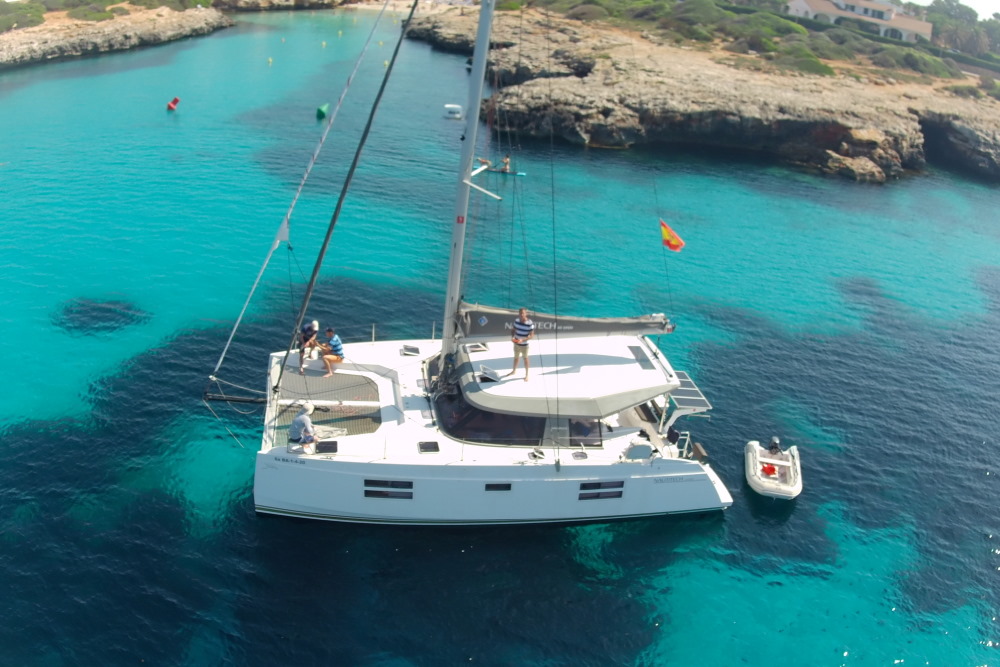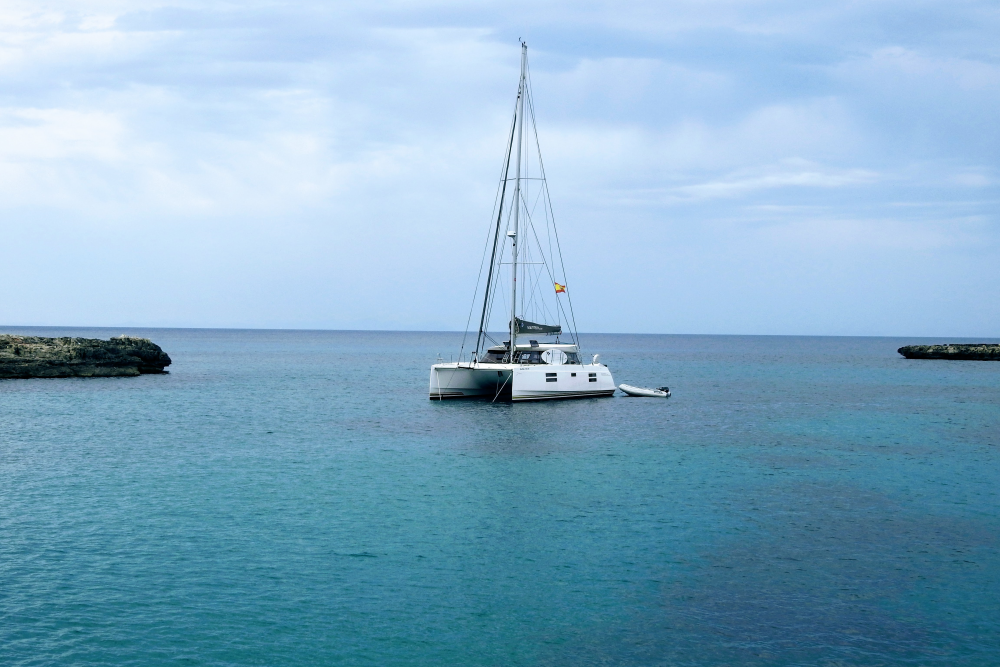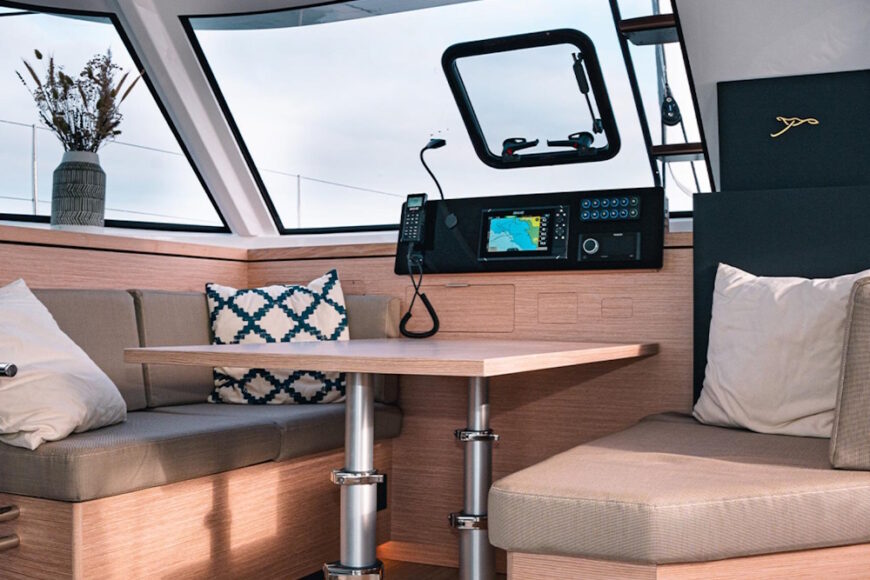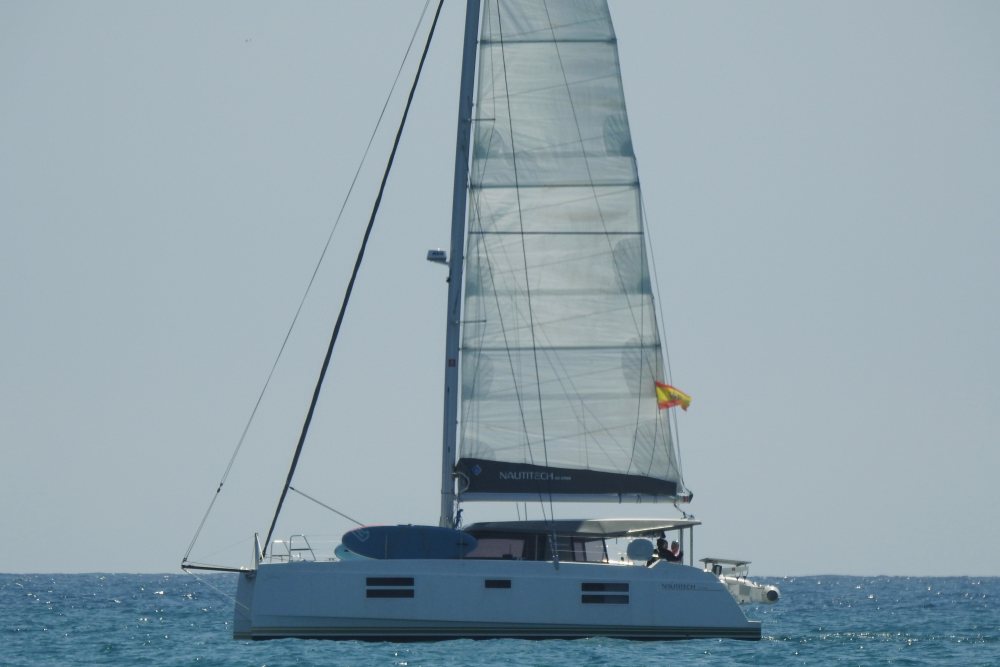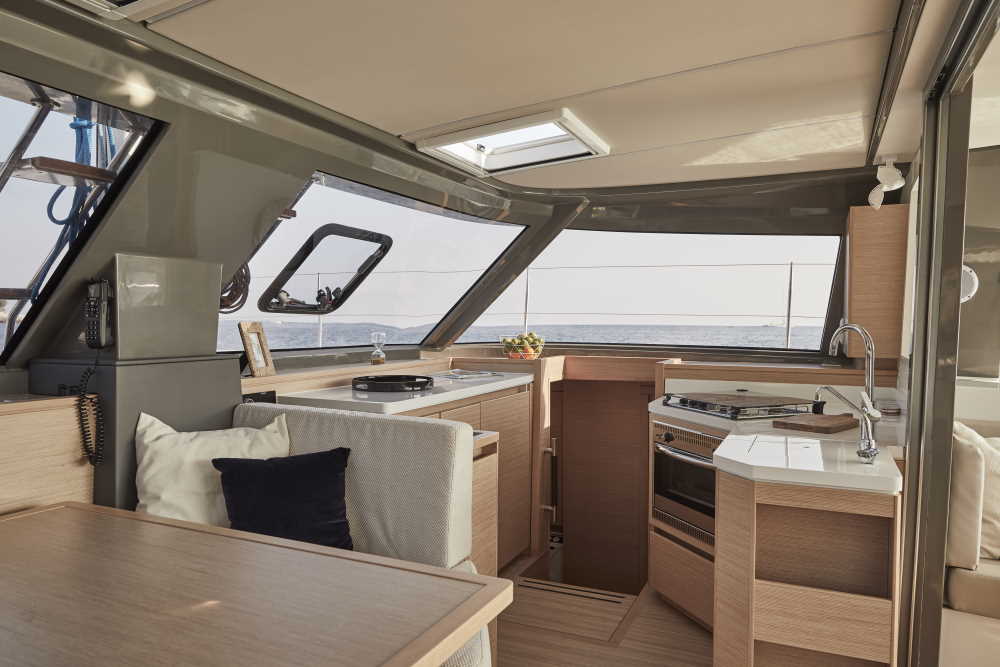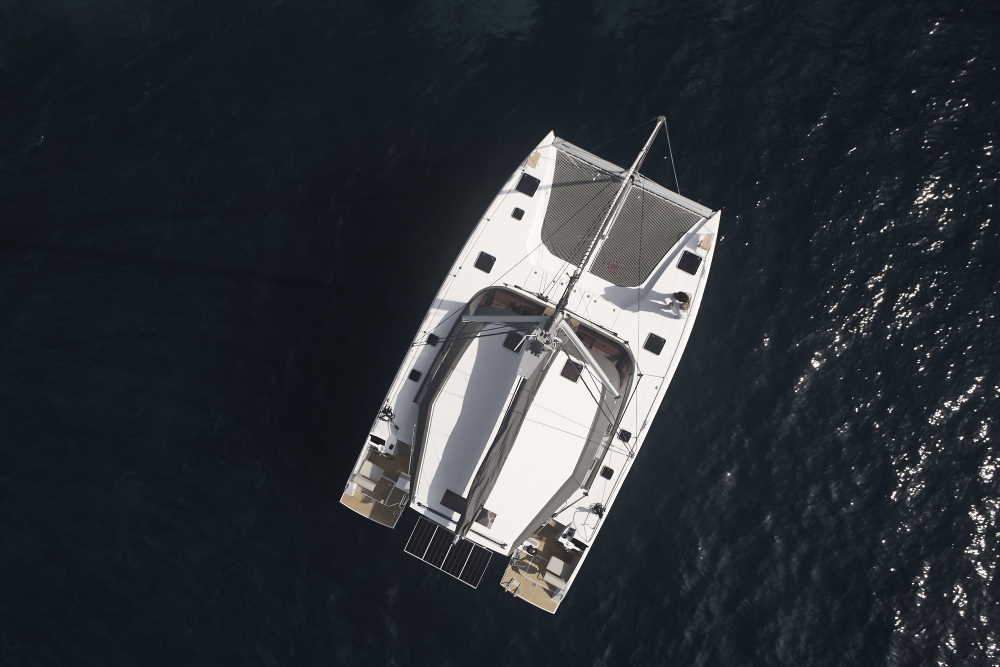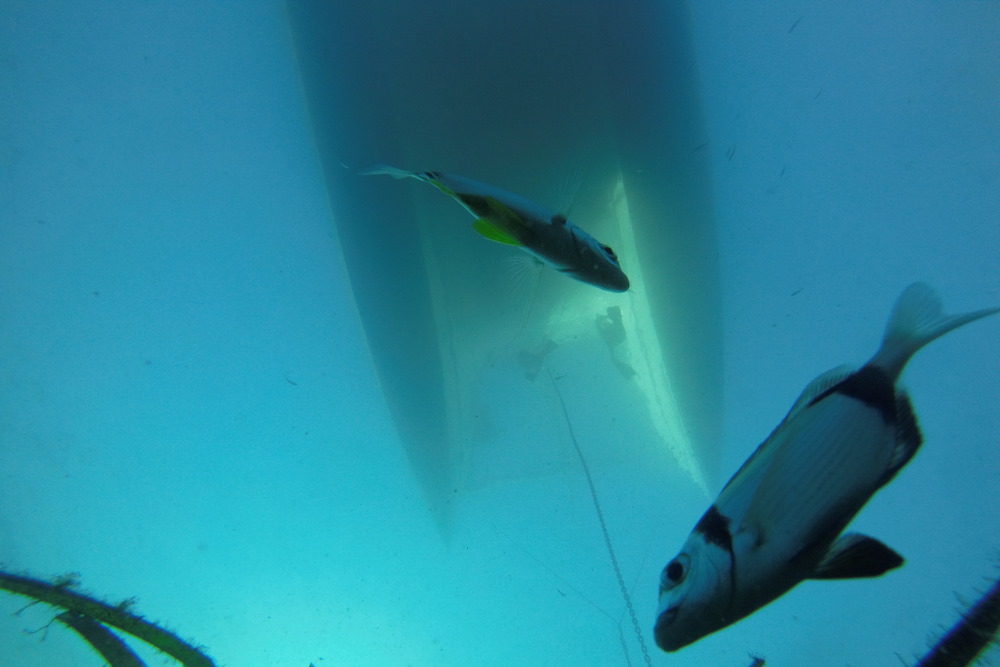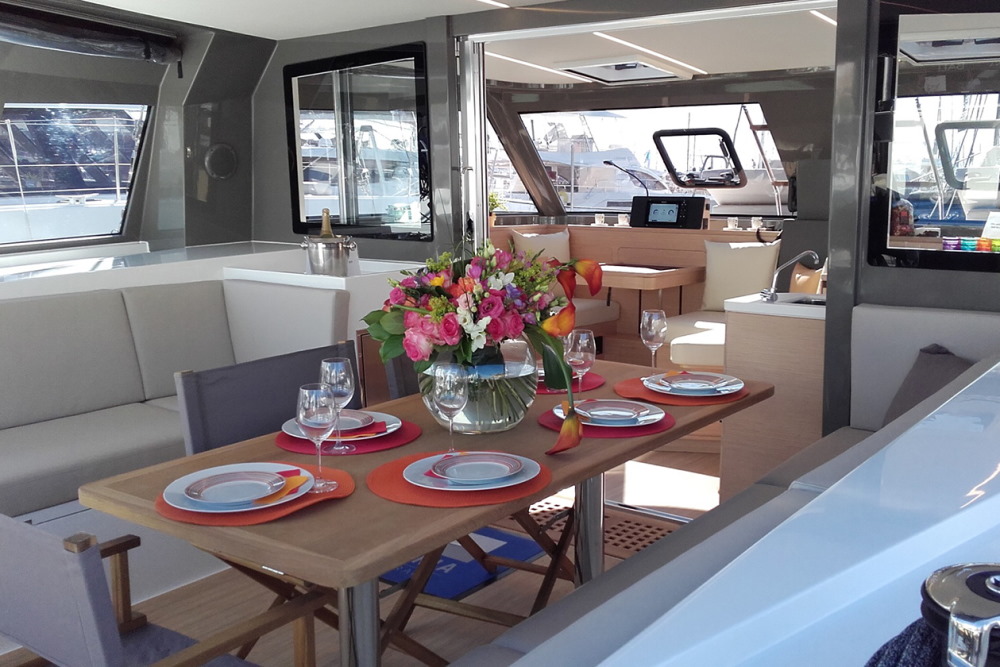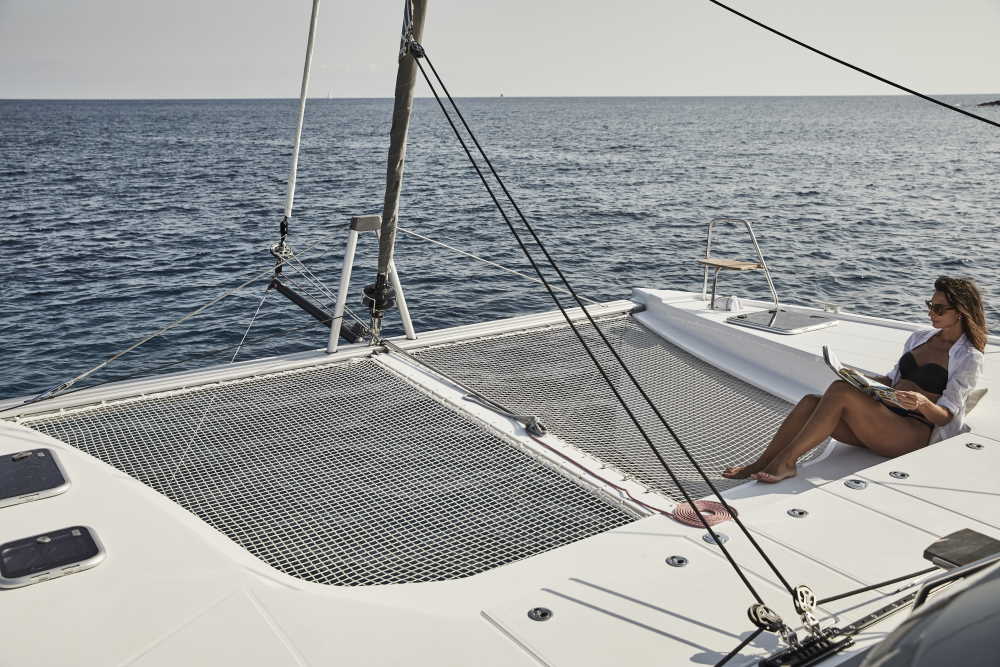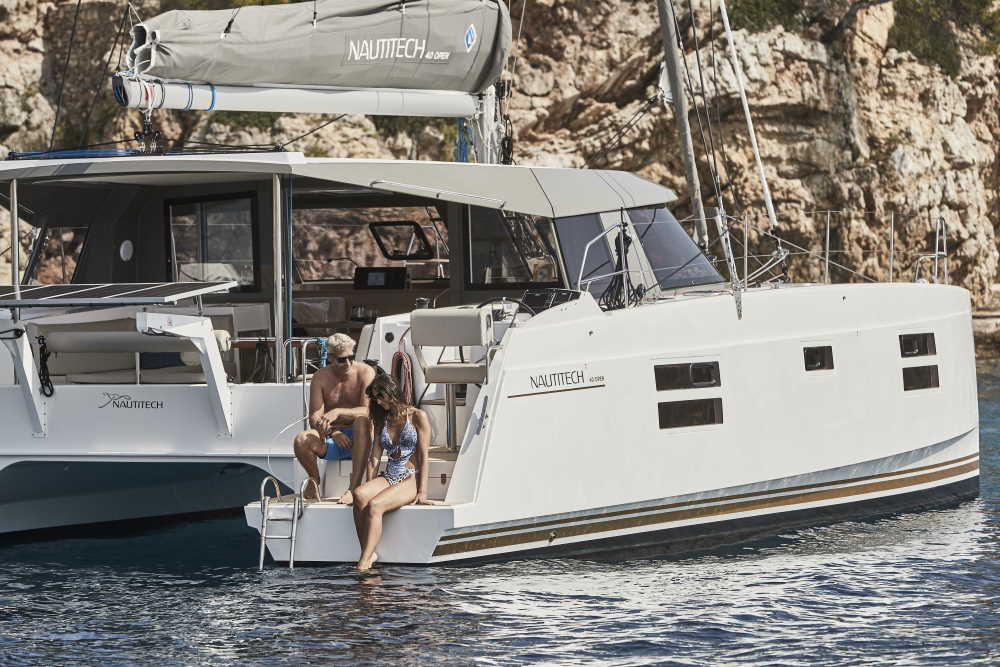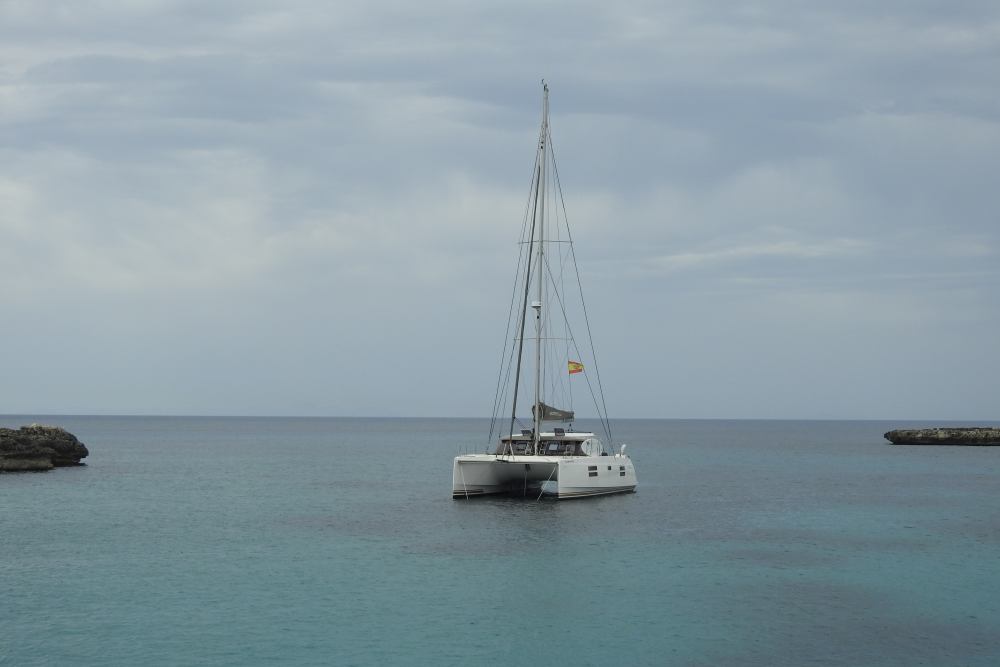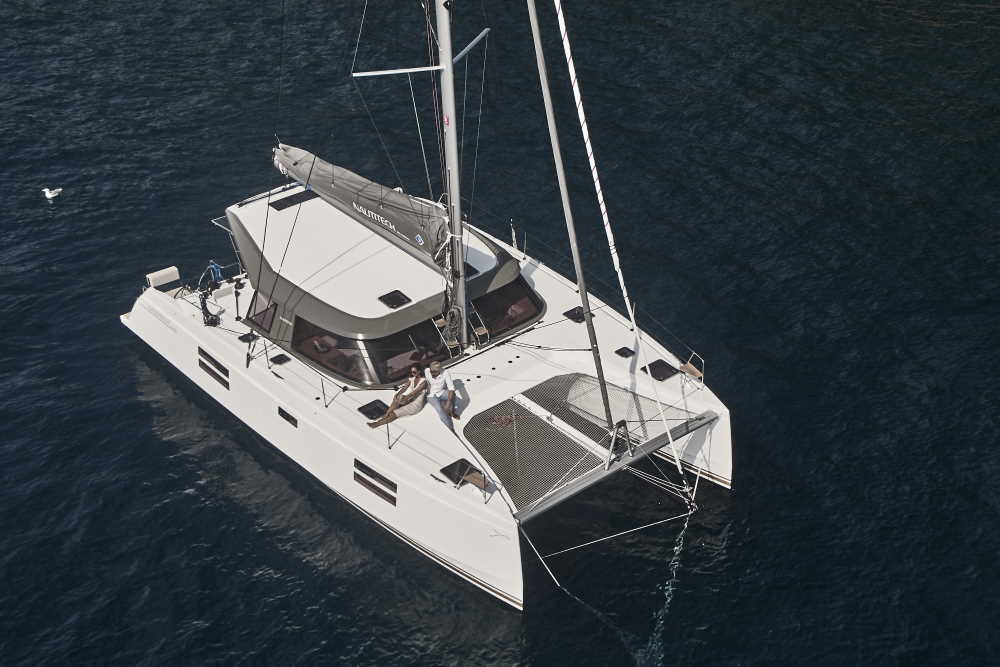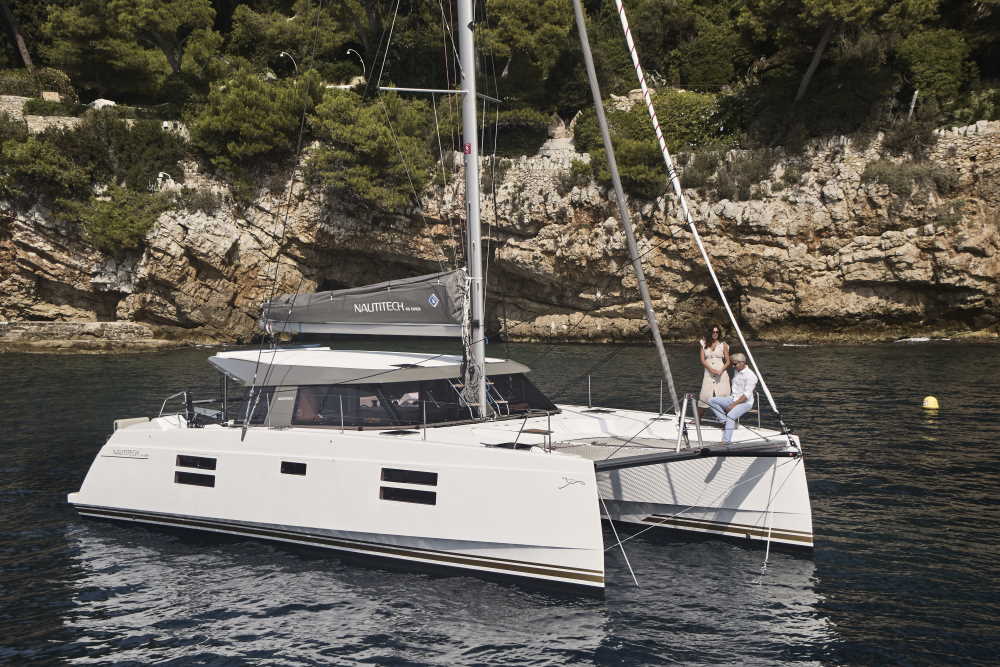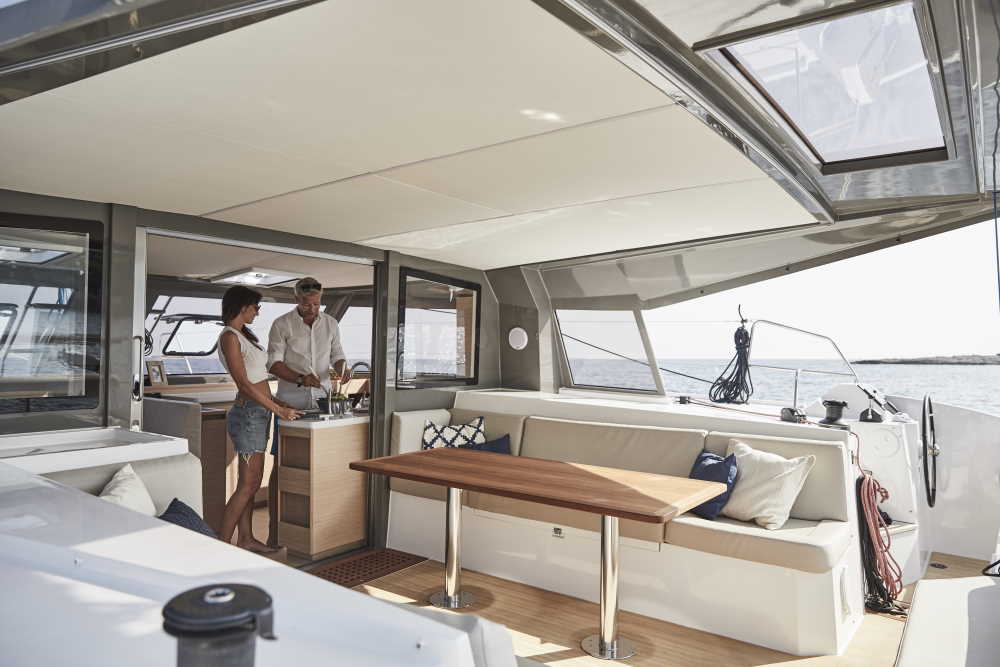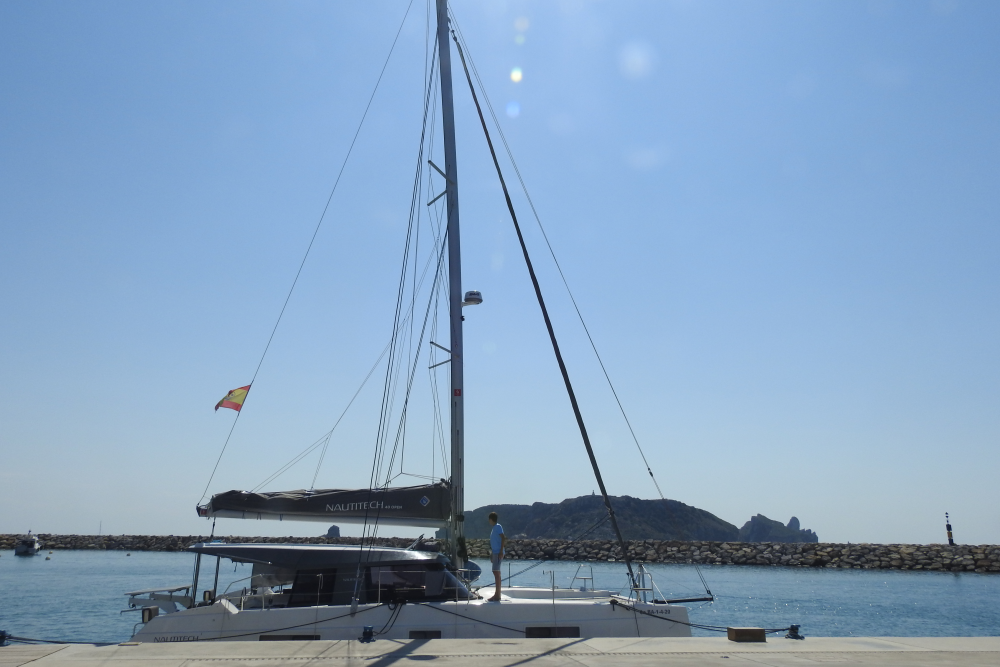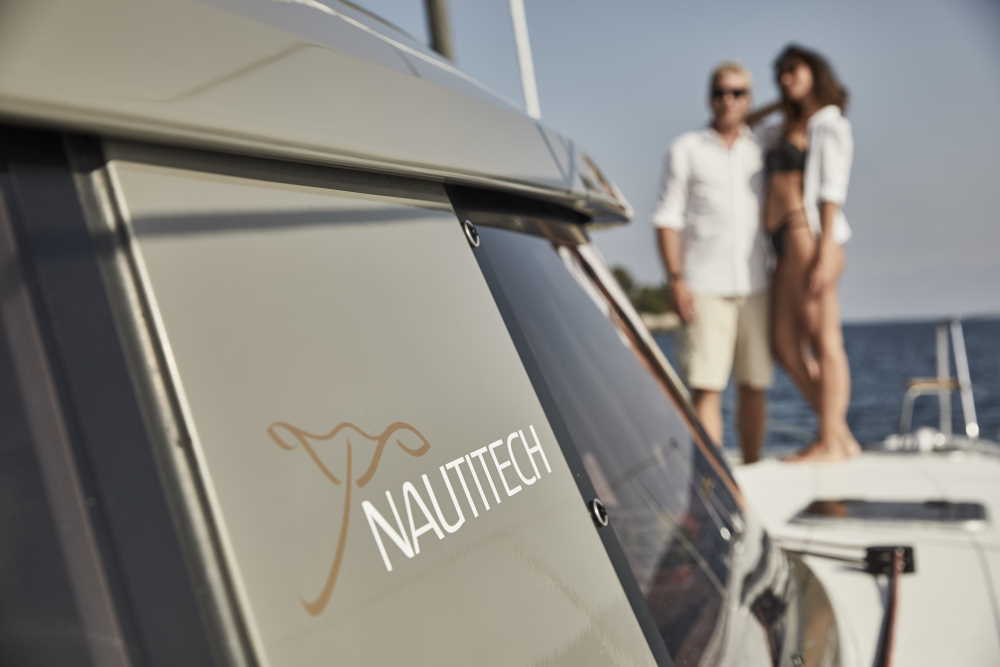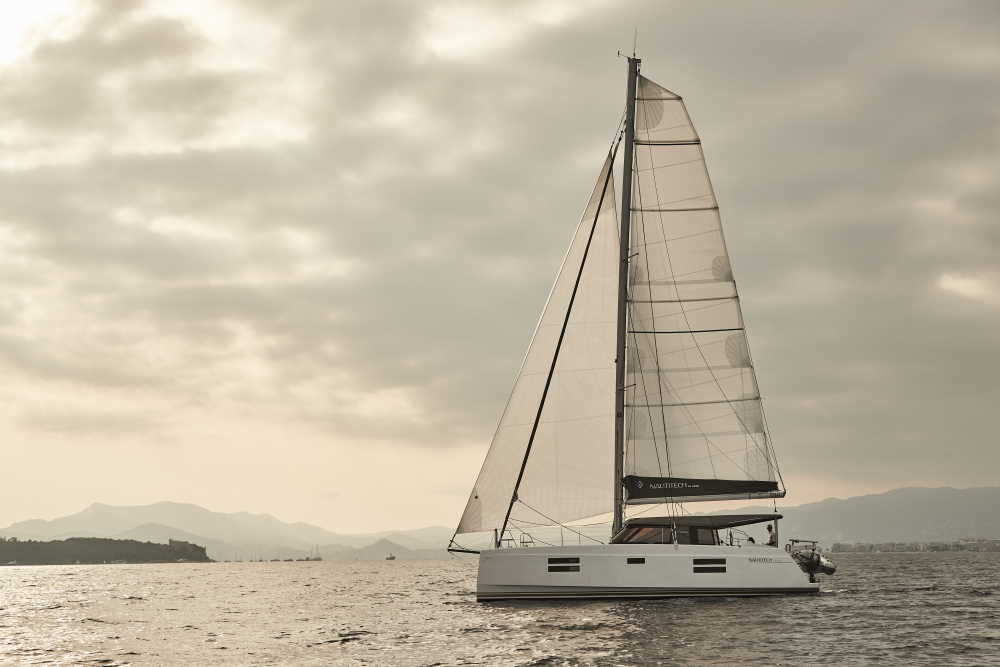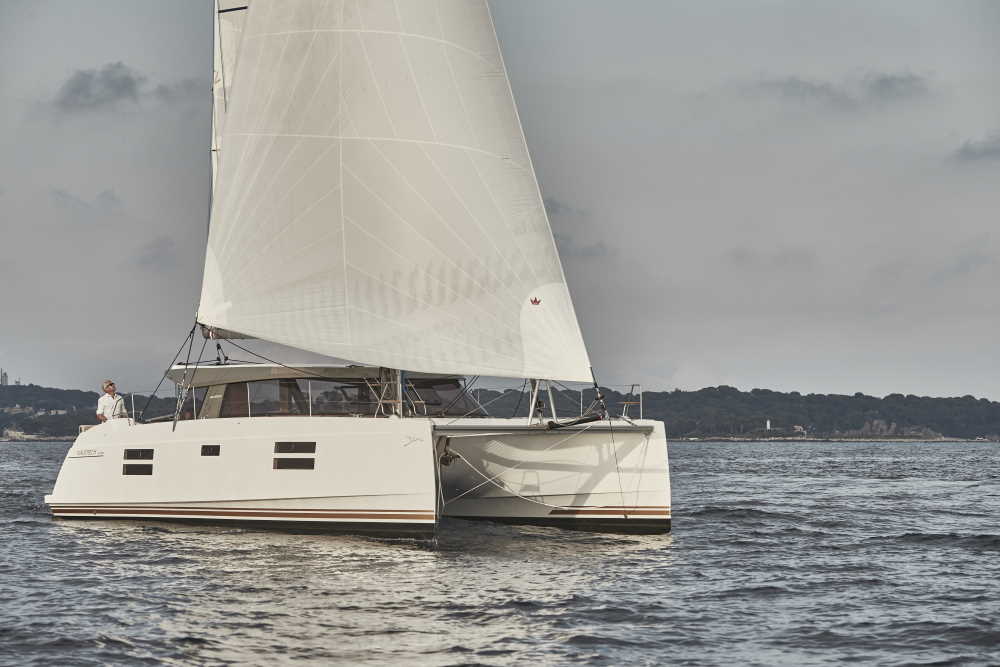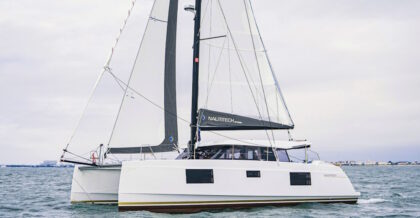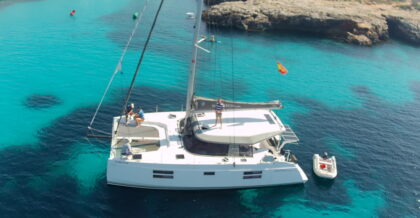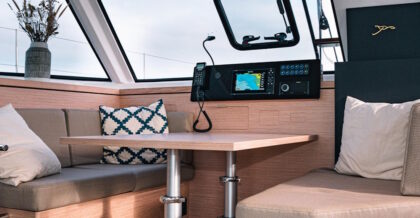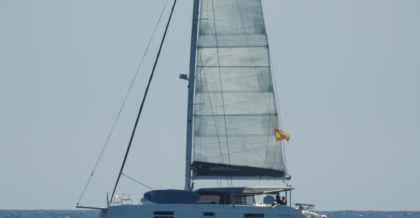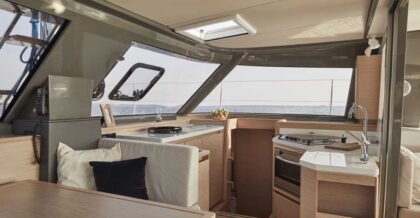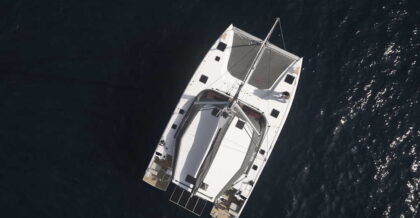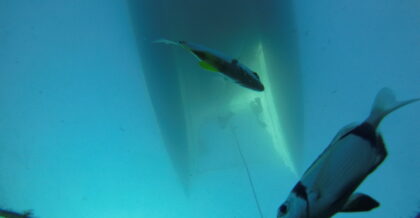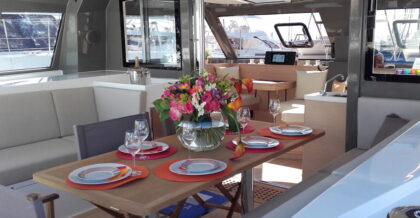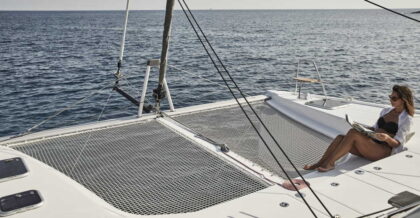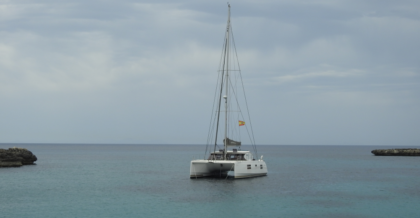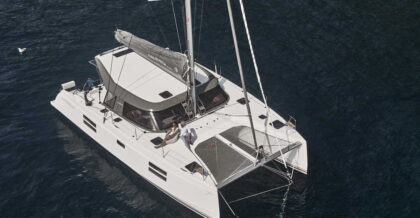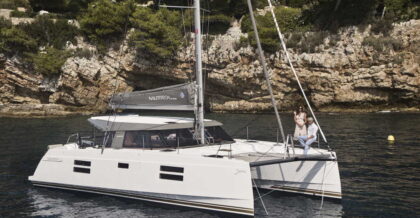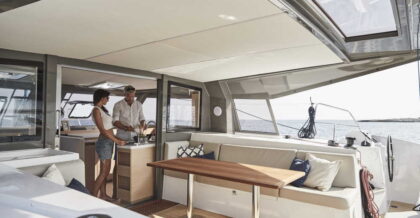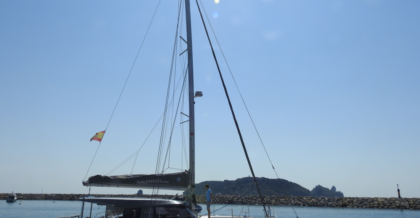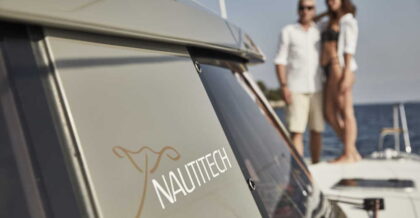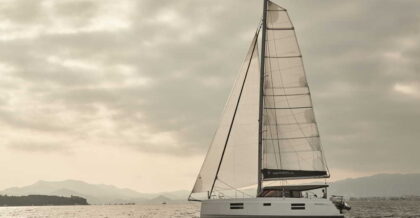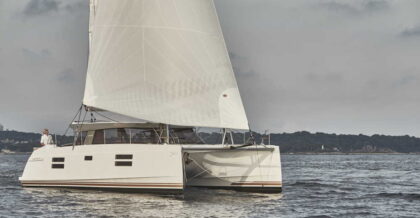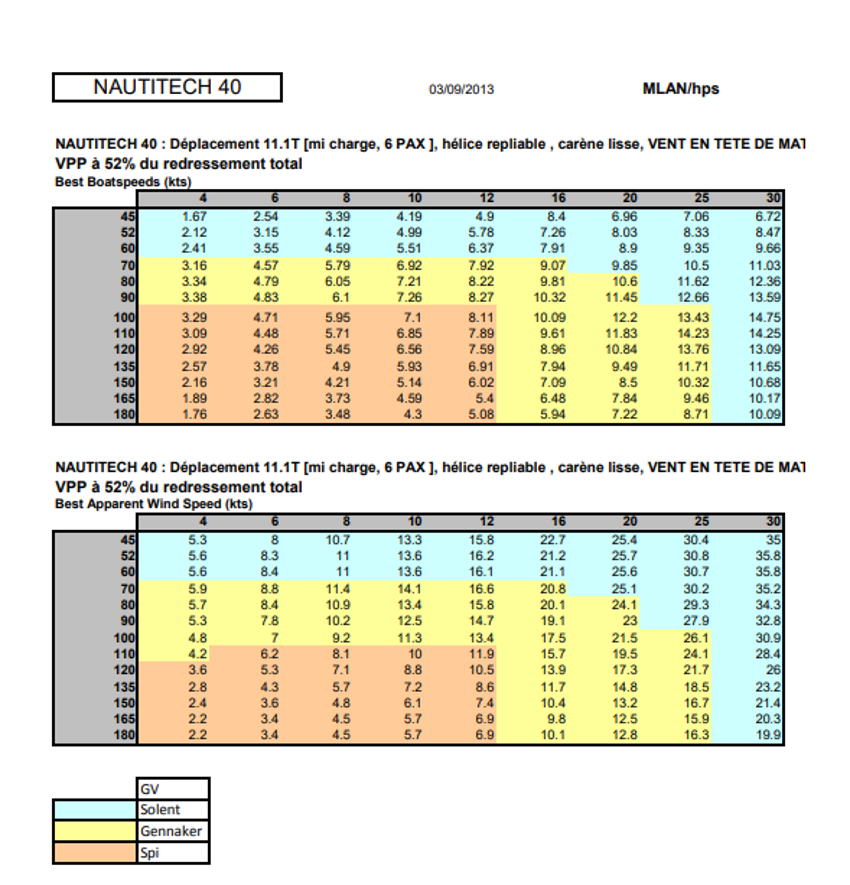Nautitech 40 Open

The Nautitech 40 Open, designed by Marc Lombard, has gone through two design tweaks in its lifetime.
Test one out yourself – charter a Nautitech 40 Open – browse our available yachts in the Mediterranean and Caribbean. We previously owned one of these boats, and we are trying to make this the most comprehensive owner’s review on the Internet.
more…
The Franco-German Axis
Nautitech is now owned by Germany’s Capital Management Partners who also own Bavaria, but their boats continue to be built in Rochefort, France. These catamarans are constructed with a resin-infused technique that results in a light, strong finish. The decks include a closed-cell foam core. The joinery is high quality on these cruising cats – especially considering their price point.
This review is from personal experience- we’ll try and keep it objective! You can also read our Owner’s review that we compiled for a prospective buyer that will give you another angle as we were answering specific questions.
– The Nautitech 40 Open is one of the lightest catamarans in her class.
– Don’t overload her and she gets going quickly.
– The reefing system is traditional – it is done from the mast.
– Plenty of living space up top thanks to the Open concept and twin aft helms
– The saloon is smaller than many of her competitors, but the aft cockpit area is big.
– There is less space down below with slender hulls for more performance.
– The boom is low. She is a seaworthy boat in a blow thank to a low centre of effort on the mainsail.
– It is also very easy to get to the boom and mainsail.
– Nautitech build their boats using foam composite rather than the balsa wood used by many of the competition.
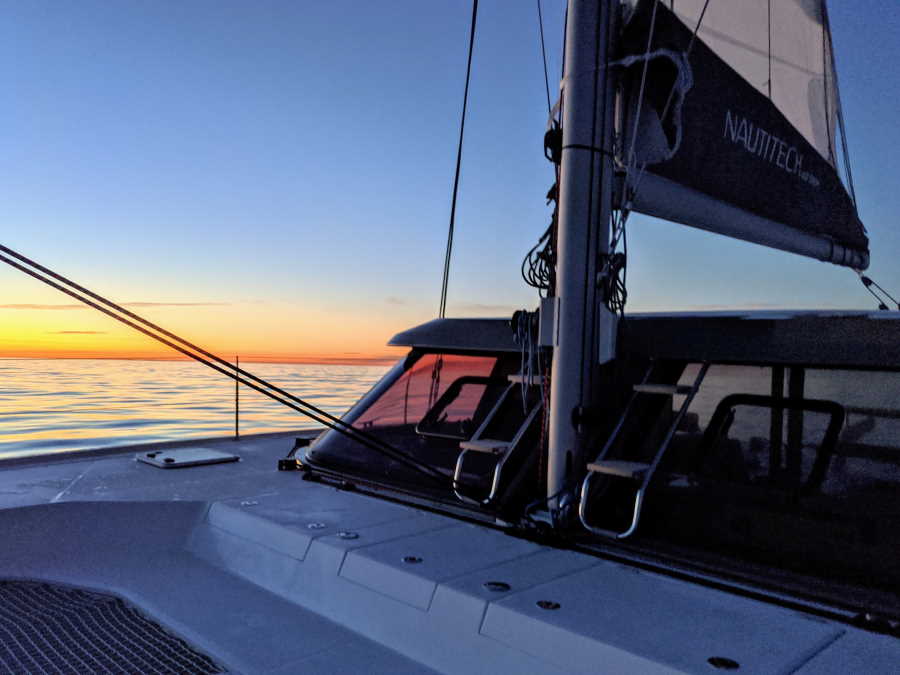
This is a cruising cat, but with an eye on performance compared to other boats like the Lagoon 380 and the “Open” concept has proved hugely popular.
She’s Light
Nautitech have kept an eye on the weight of the boat (she’s only 8.5 tonnes light) and as long as you don’t go crazy on the gear, she accelerates quickly.
19 Knot Surf
Our top speed on our boat so far is 19 knots (OK we were surfing, but even so). In decent conditions, you should hit the early teens. In light winds, we’ll go 6 kts on 10kts of wind just with the mainsail and self tacking solent.
Order the Bowsprit
The Nautitech 40 Open comes in all sorts of configurations- it’s worth ordering the bowsprit as this opens up all sorts of options for head sails to complement the efficient square-top mainsail.
We run the 70 sq.m gennaker off there and there is also an option for a 55 sq.m code 0 if you want to point higher. We have heard from other owners that the Code 0 comes out of the bag frequently. We also have a parasailor on our wish list for when we make it to the Trade Winds.
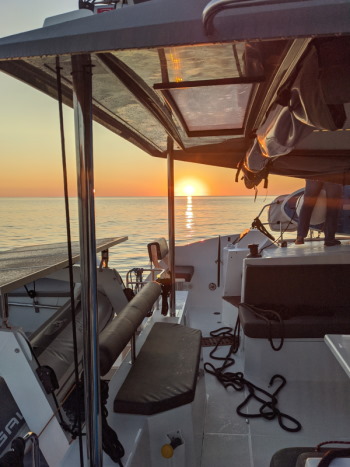
Minimum Fuss Tacking
She comes with a self-tacking jib and a light asymmetric sail at the bowsprit (that’s an option). The mainsheet leads to a traveler on the bimini and down to the cockpit, and the solent/jib sheet (stbd) and furling line (port) run back to winches and clutches at twin outboard helms.
There are also two winches and clutches on the aft beam to help with the traveler and raising the tender.
The main halyard also comes aft to the starboard side and you can order an electric winch as an option to help you raise the mainsail. Or you can use the winch at the mast, a handy back up.
You Reef from the Mast
All the reefing lines and the topping lift are managed from the mast which means getting out on deck to shorten sail. I am thinking of reorganising the running rigging on our boat and lead all of the lines back into the cockpit like the bigger boat, the 44.
Or that’s what I thought when I first bought her. I have to admit, the longer I have the boat, the more I am warming to the simplicity of this system. There’s less friction, shorter lines and it’s easier to get tension on the halyard once the reef is strapped in. You need to be organised though to minimise the time you spend at the mast.
There’s a handy winch on the mast for your reefing lines and gennaker halyard and another clutch for the main halyard so that you can manage this from the mast if you like (can be handy if you are sailing single handed). I have added some frictionless rings below the mast winch for the reefing lines to improve the angle that they come onto the winch as I was have problems stripping lines on the clutches.
One thing I have noticed is that there are plenty of places to clip on, and a nice sturdy rail on the coachroof aft. There’s a deep well after that to grab onto as you move forward towards the mast- she feels safe in that respect.
The boom is low and very easy to access from the bimini top. There are some open steps by the mast to climb up.
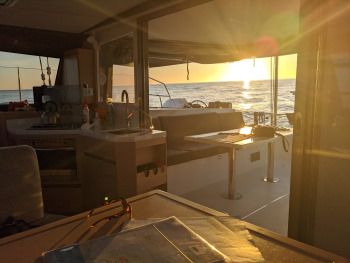
Helm with the Wind in Your Hair
Not everyone is a fan of the Nautitech Open helm position- she sports twin aft helms (read our Excess 11 review for another boat with a similar configuration) and there is an option for helm biminis for improved protection. Personally we love this configuration- it’s similar to a Catana (with more substantial helm seats) and gives you a real sailing feel when you are under way. Because the fibreglass sides are high by the helms, you feel secure tucked in here. There’s a point to clip onto under the seat if it gets rough.
Easy to Trim your Sails
It’s easy to keep an eye on the tell-tales on the head sail- just as you would on a Hobie 16.
more…
If the weather turns nasty, you either helm with the autopilot in the saloon or tuck in under the bimini close to the helm. Make sure you order the electric winch at the Starboard Helm. Raising the mainsail with that is easy, although I always raise the sail manually to be begin with until the first couple of battens are clear of the lazy jacks.
There is an option for having throttles on both helms. The standard configuration just has them on the starboard side (this is what we went for: the budget ran out.)
She Accelerates Quickly
Because she’s relatively light, she gets going quickly and Lombard has shaped those hulls so that they slip through the water nicely below the waterline.
more…
Don’t load her up too much though. Narrower hulls means less living space down below, so she’s not as spacious as a Lagoon in the cabins (there’s your compromise). In the cockpit, it’s a different story with that Open concept and the twin helms aft.
Docking the boat is a breeze as well, although, to repeat myself, try and go for the option of having those throttles on both helms if you can afford it. Because you are so close to the transom, one person can theoretically helm and throw the ropes. It’s easier with 2 of course.
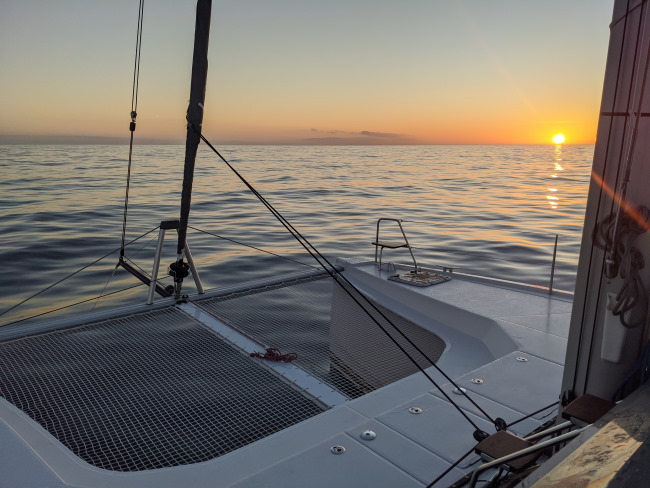
She Goes Through the Wind Well
She tacks easily and as you come off the wind, she’s fast! There’s a Youtube clip showing a 40 doing 20 knots doing the rounds (we saw over 19 knots surfing on our delivery trip).
And when you hit those numbers in that helm position, you’ll have a smile plastered all over your face.
A Nippy Boat
On average, you’ll see 7-9 knots. The nice thing about her is that she gets moving nice and quickly in light winds and this is where that gennaker option comes in handy. If the wind hits 7 knots, you should be sailing. In a freshening breeze, you should see low and even mid teens on a reach.
Sailing Close to the Wind
Upwind, she points well for a fixed keel catamaran- a Seawind is probably the only boat that can match her. She’ll point happily at 50 to true but you are probably better off pointing at 55 (more speed, less leeway).
more…
The sweet spot seems to be around 40 to 45 degrees AWA.
In lighter winds the performance drops off, unless you have a Code 0 in your sail locker of course. If your budget ran out on the gennaker, just stick the leeward engine on at low revs to point higher and you will get where you need to go. That would be about 30 degrees apparent, 45 true.
At the end of the day, if you are going to be close hauled all day, every day on a multihull you are best off with dagger-boards, but the 40 Open is no slouch close to the wind, especially if there is a decent breeze. In lighter air, the performance does drop off when compared to a dagger-board cat like an Outremer but that is the case for any fixed keel catamaran.
The Nautitech 40 Open comes with 30 HP engines as standard, but I would recommend the upgrade to the 50s (used to be 40s). One engine will push you along at around 6 knots at 2200 RPM in calm conditions. With both engines going, she’ll move comfortably at 7 depending on the sea state.
If the waves are building, it’s often advisable to power up both engines to help you punch through the waves for a more comfortable ride if you are heading upwind.
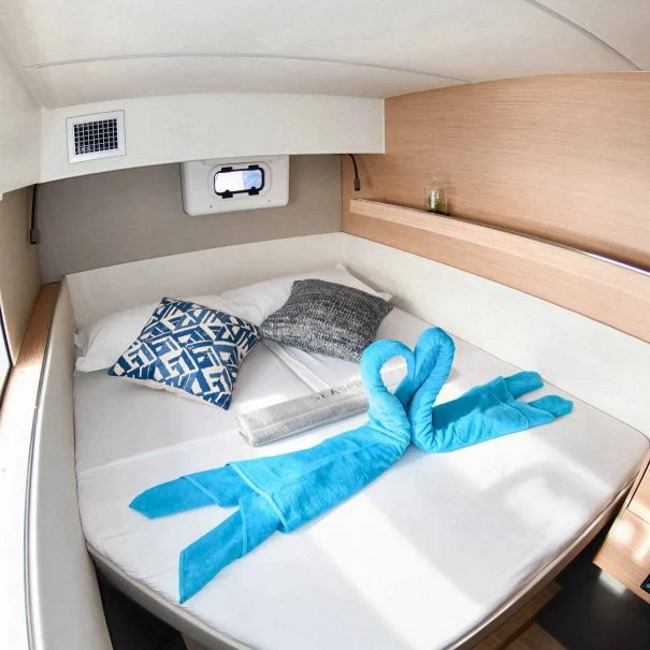
A Big Interconnected Space
The design of the Open 40 is all about giving you more space in the cockpit and less in the saloon, so this boat is particularly suited to warmer climes like the Med. Below decks, the configuration is either three cabins (Owner’s) or four Cabins (charter version).
Slender Hulls with a Chime
The hulls aren’t as spacious as a Lagoon (there’s your speed/space trade off), but they are very comfortable and there´s still far more space than you would get on a monohull, although Lombard has sculpted chimes into the hulls (they flare at the top) like the Catana 53 which gives a good performance/comfort balance.
All the cabins have huge windows through which you can watch the world go by.
Option for Night Watch Bed
There is an option for a telescopic table in the saloon (port side) which we have gone for. This gives you a night watch berth if you need it.
Why No Double Sink?
The galley is to starboard and is nicely designed with everything to hand. We would have liked to have seen a double sink, or a sink and a half. There’s room. The other thing that we find annoying is that the galley tap is very short which means you get a lot of splash back against the doors. We are going to fit a tap with a longer arm.
When you are cooking at the burners, you are facing aft connected to that large outdoor cockpit area. The doors can be thrown wide open to connect the two spaces into one joined up area: hence the name, the Open. The position of the cupboard behind the burners is not great. You have to watch yourself here is you are cooking and leaning over the hob to get stuff out of the cupboard.
There is an option to go for an additional fridge in the aft cockpit and a freezer in the starboard hull, both of which we would recommend.
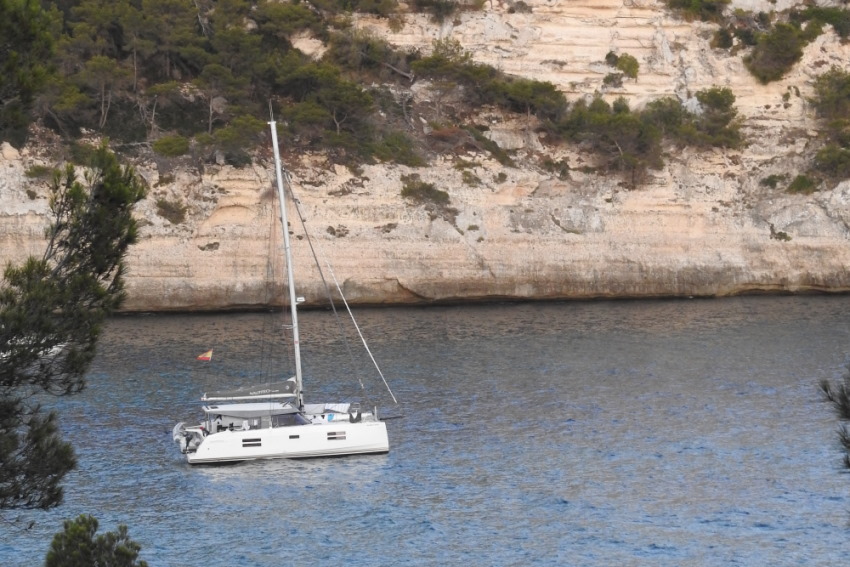
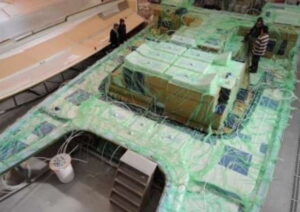
It’s worth spending a bit of time talking about the build process. Different density foam cores are used, depending on the location and loading in different parts of the boat. During the infusion process, the vacuum pressure, temperature, and resin flow are tightly monitored for tight weight tolerances.
All of the bulkheads are glassed into the hulls, and all interior framing and furniture is built in which makes for a stiff, strong and quiet structure.
more…
The big difference between Nautitech and some of the competition is the use of foam composite, versus balsa core. The hull, deck and roof are built with a fibreglass and polyester sandwich infusion. This allows for significant weight savings.
The process used is: VacuTec a vacuum infusion technology. This helps to keep the boat light, reducing the weight by 20% and emissions from the work processes by up to 80%. You get lighter and stronger hulls, and protection against osmosis by isophthalic acid resin in external systems.
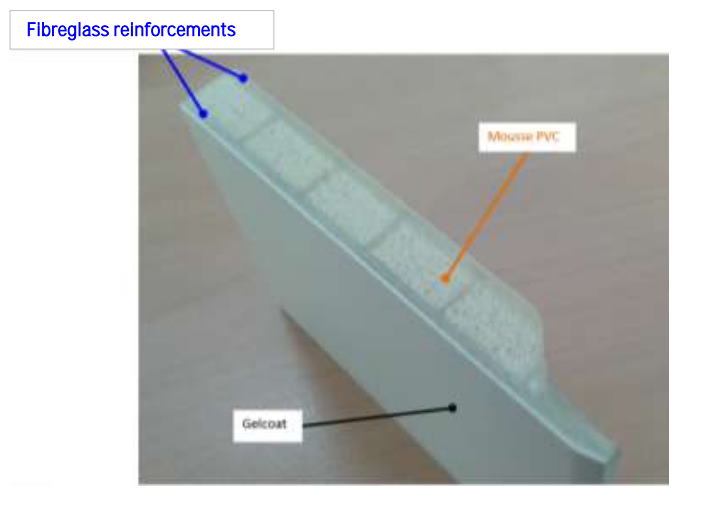
Nav Pack Options
Nav-Pack Cruise
2 x B&G Triton Displays (1 x per helm station) with Speed-, Depth-, Wind-Transducer
2 x B&G Zeus 9” chartplotter (stb & port helm stations)
Chartplotter functionality on B&G Zeus 9″ at nav station
B&G Autopilot, B&G Autopilot control unit (stbd helm station)
B&G V90 VHF incl. Antenna (nav station)
B&G AIS Transmitter/Receiver
B&G H50 wireless VHF unit (stb helm station)
Nav-Pack Advanced
includes Nav-Pack Cruise plus additional
1 x extra B&G Autopilot control unit (port helm station)
NMEA Connector for PC at nav station
B&G Forward scan
Other Options
B&G 4G Radar antenna
View the Nautitech 40 Open Brochure
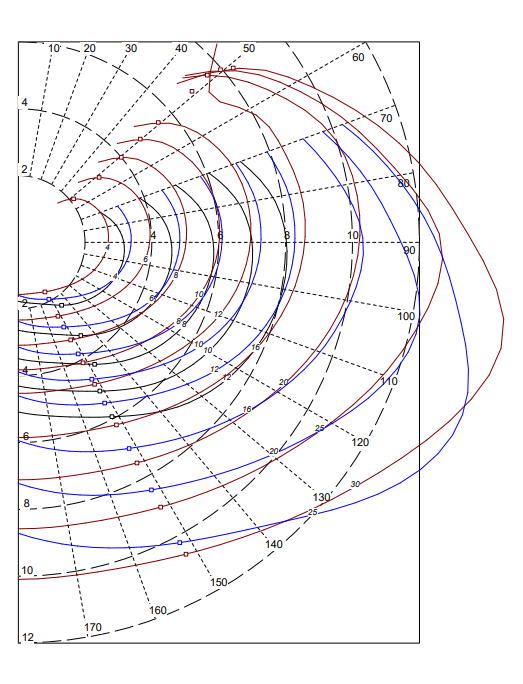
Issues to Monitor on New Boats
All new boats have teething problems- that is not a problem that is unique to Nautitech. We logged the following issues on our own Nautitech 40 Open, or through the Nautitech Owner’s Facebook Group, so hopefully this will help you to isolate any problems at the handover stage and minimise the work later.
Hopefully you won’t have to deal with any of these problems (but you would probably be the first boat owner that happened to 😉 ) The bottom line is, these are niggles, not serious problems. Some of them have been corrected on later models (eg sun damage on the grey roof. They switched to white)
more….
Batteries. Our boat was fitted with Genois batteries: 5x LPC12-75 for the service batteries and 2x LPC12-100 for the starter batteries. Within 18 months, they were dead 4 hours after fully charged, and that was with light use, due to Covid (mostly connected to shore power). Horizon Yachts have had similar issues with the batteries supplied by Nautitech. My advice would be to insist on another brand of battery. You can actually fit 6 service batteries in the trays in the port hulls. The standard upgrade takes you to 5.
Noisy steering – the steering became very noisy on our boat on our delivery passage sailing across the Bay of Biscay. I mean really noisy, like a cat screeching every minute. It was difficult to isolate, but it turns out that the rods that connect the helms under the aft cockpit run through plastic tubes. These weren´t secured properly, and the rods were playing the tubes like a violin. Played by a terrible violinist I might add. An easy fix, once we had isolated the problem, but check the workmanship around the steering.
Stripped reefing lines. The teeth on the jammer at the front of the boom which secure the reefing lines were very sharp on our boat. If lines are flailing about in heavy weather, this can strip the reefing lines. Make sure you lead the lines through the block you should have been given before wrapping them around the winch. If you don’t do that, the angle will be such that you may strip the lines on the edge of the casing – also very sharp. Check closely around the front of the boom and file stuff down if you need to. We now run our reefing lines through frictionless rings below the mast winch has solved the problem.
B&G Autopilot disengaging. This seems to only happen in “Nav” mode when you are navigating to a waypoint. We never resolved that one. Faulty wiring somewhere? Software?
If you ordered the heating system, check the air inlet and exhaust. There should be a bend in this to make sure that seawater does not get into the diesel burner. Ours wasn’t installed properly and failed in big seas crossing the Bay of Biscay. Nautitech fixed this on the guarantee, fair play.
Sliding Door. Check this closely. We had a problem with the door jumping out of its tracks mid passage in waves – pretty dangerous! On closer inspection, Nautitech had only used one screw instead of two on the plastic wedge which the door comes to a rest on in the open position. Check the door doesn’t slide a little when it is locked- often this is just a case of small adjustments.
Manual bilges – check the pump handles (at the back of the cockpit benches) work and are properly sealed. Fill up the bilge manually with a bucket of water and pump it out yourself to test the bilges.
You can test the auto bilges at the same time. We had alarms going off with water running back and forth on our passage as the levels weren’t set correctly. Again, an easy fix, but do it on the handover.
Owners have reported issues with the bilges running continuously. You should check the fresh water pump (Marco) first to make sure there are no leaks coming from there. Then check the hoses. If there is a loop at the outlet the pump won’t clear all the water and some is left in the hose. Also if the non return value on the pump has failed it will run back out of the pump and the pump will start up again. Bottom line is, test all the bilge pumps extensively during the handover. When you take the boat speed paddle wheel out to clean, you will get a bit of sea-water in the port bilge. Pump it out manually to make sure the bilge is dry.
Sun damage on the coachroof (grey strip) on older models. Many owner’s have reported UV damage on the grey strip running around the coachroof. Our boat was no exception: after only 18 months the finish is faded and mottled with the sun. Newer boats come with a white coachroof, solving the problem.
Summary
Any boat is a compromise, and we think the Nautitech 40 Open is a great sailing boat at a reasonable price, but they could do with improving their after sales service.
Lombard Design has done a great job of designing a boat with so much living space (the Open concept) that is this quick. The hulls are narrower than other boats in her class, but there is plenty of room upstairs thanks to that big joined up space.
FAQs
We’d recommend upgraded engines (now 50HP) if you can manage it in your budget, plus folding props (giving you an extra knot), electric winch on starboard helm, bowsprit with gennaker, radar, the fridge in the cockpit, freezer in starboard hull, additional service batteries (insist on another brand rather than “Genois”), solar, inverter, Fusion audio system and the salon dining table (lowerable).
If you can afford it, go for the throttles on both helms, the anchor windlass control at the helm, freezer in starboard hull, heating system. The Explorer version is the pack to go for if you can afford it. The full aft cockpit enclosure is great too, they have extended it right back to the bench on the transom in the newer boats. The teak looks nice but adds weight. Same with the outside teak table.
Well, the length obviously, but these 2 designs are very similar. In the larger model, all of the lines come aft to the helms which is a plus. The aft cockpits are a similar length (the 44 is beamier), but the saloon in the 44 feels much bigger – it’s probably around twice the size. You can configure the 44 with an overlapping genoa instead of the self-tacking solent. You cannot do this on the smaller boat.
You are not going to point as high as a daggerboard cat in light winds, but for a fixed keel cat, the Open 40 points very well into the wind, especially with the weight off and with clean hulls. In a decent breeze (13kts and over), she will point as close to 30 degrees apparent but your speed will drop and you will be losing about 10 degrees on leeway. To maximise your VMG, drop off another 5 or 10 degrees (so 40-45 degrees AWA or around 55-60 TWA and your speed will come up and the leeway will drop off a bit. Sheet in tight and put some twist in the main with the mast track car to windward.
We hit 19.2 knots off the coast of Portugal (surfing). You should hit low teens on a beam reach in the right conditions with the gennaker up.
We had a 3.10 Gala with an 8HP Yamaha Engine (in hindsight I should have gone 9.9 HP). This is about as big as you want to go, although I know another owner has fitted a Brig 330 which is 320 long, but it was tight.
At the time of writing, the base price was just over €515,000. But then you have to add on all of the options (eg Lifestyle or Ocean Cruising pack). Once you add extras like a water maker, heating, engine upgrade, navigation system and so on you can easily add on a extra €100k – 150k or more.
Contact Katamarans
Share your details with us and we’ll be in touch to discuss further.
"*" indicates required fields

